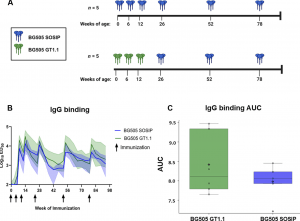A recent study suggests that early-life immunisation against HIV could provide robust protection against the virus, particularly in adolescents who face a heightened risk of infection (Figure 1). The research demonstrated that a series of six vaccinations, administered to young non-human primates, successfully stimulated initial steps of a potent immune response. This significant milestone represents a crucial advancement towards developing a vaccine capable of offering lifelong protection against HIV.

Figure 1: Development of durable, high-magnitude Env-specific plasma IgG responses after BG505 SOSIP immunization.(A) Infant RMs received 50 μg of either BG505 SOSIP or germ line–targeting BG505 GT1.1 (n = 5 per group) with the 3M-052-SE adjuvant. (B) Plasma IgG binding responses were measured to the matching immunogens BG505 SOSIP (group 1; blue) or BG505 GT1.1 (group 2; green) for each group by ELISA. A bold line represents the median, and a shaded area represents the range. Black arrows indicate immunization time points. (C) AUC analysis for vaccine-elicited plasma IgG binding responses. Individual data points are empty circles. The group mean weekly AUC value is a filled diamond. The median represents the midpoints of the box, with maximum and minimum values used to create the arms. The median AUC responses were similar between the two groups (P = 0.23).
As adolescents become sexually active, their risk of HIV infection increases dramatically. Additionally, the immune systems of infants and children are generally more responsive to the virus compared to adults. By priming the immune system early, researchers aim to establish a strong foundation for combating HIV infection.
HIV primarily attacks CD4 T cells, a type of immune cell. Without effective treatment, infection can be fatal. Vaccine researchers have been focusing on stimulating the immune system to produce “broadly neutralizing antibodies” against HIV. These antibodies target a specific part of the virus, preventing it from entering and infecting CD4 T cells. In this study, researchers modified a previously developed vaccine to enhance its ability to stimulate the production of these protective antibodies.
By introducing specific mutations into the viral protein, the researchers were able to activate a particular set of B cells that are essential for generating a broadly protective immune response. Engaging the right B cells is crucial for developing a vaccine that can effectively combat various strains of HIV.
The modified vaccine was administered to young primates in multiple doses, starting shortly after birth. The results were promising, with three of the five animals developing antibodies that showed potential for neutralizing a wide range of HIV strains. However, further research is needed to reliably elicit a full-blown broadly neutralising response.
Journal article: Nelson, A. N., et al. 2024. Immunization with germ line–targeting SOSIP trimers elicits broadly neutralizing antibody precursors in infant macaques. Science Immunology.
Summary by Stefan Botha










